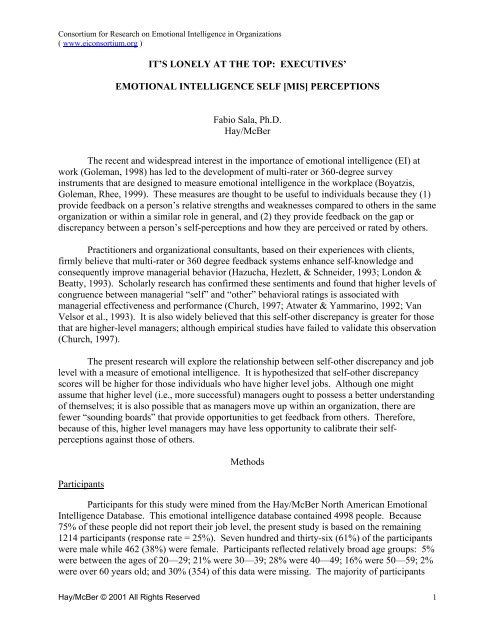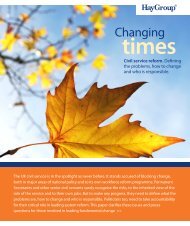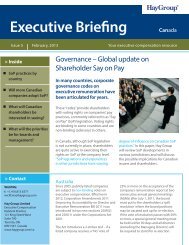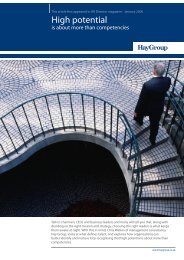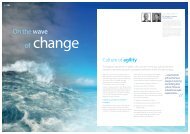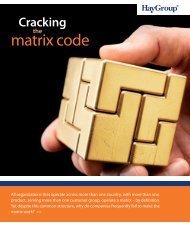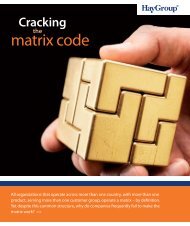Emotional Intelligence Self-(Mis)Perceptions - Hay Group
Emotional Intelligence Self-(Mis)Perceptions - Hay Group
Emotional Intelligence Self-(Mis)Perceptions - Hay Group
Create successful ePaper yourself
Turn your PDF publications into a flip-book with our unique Google optimized e-Paper software.
Consortium for Research on <strong>Emotional</strong> <strong>Intelligence</strong> in Organizations<br />
( www.eiconsortium.org )<br />
IT’S LONELY AT THE TOP: EXECUTIVES’<br />
EMOTIONAL INTELLIGENCE SELF [MIS] PERCEPTIONS<br />
Fabio Sala, Ph.D.<br />
<strong>Hay</strong>/McBer<br />
The recent and widespread interest in the importance of emotional intelligence (EI) at<br />
work (Goleman, 1998) has led to the development of multi-rater or 360-degree survey<br />
instruments that are designed to measure emotional intelligence in the workplace (Boyatzis,<br />
Goleman, Rhee, 1999). These measures are thought to be useful to individuals because they (1)<br />
provide feedback on a person’s relative strengths and weaknesses compared to others in the same<br />
organization or within a similar role in general, and (2) they provide feedback on the gap or<br />
discrepancy between a person’s self-perceptions and how they are perceived or rated by others.<br />
Practitioners and organizational consultants, based on their experiences with clients,<br />
firmly believe that multi-rater or 360 degree feedback systems enhance self-knowledge and<br />
consequently improve managerial behavior (Hazucha, Hezlett, & Schneider, 1993; London &<br />
Beatty, 1993). Scholarly research has confirmed these sentiments and found that higher levels of<br />
congruence between managerial “self” and “other” behavioral ratings is associated with<br />
managerial effectiveness and performance (Church, 1997; Atwater & Yammarino, 1992; Van<br />
Velsor et al., 1993). It is also widely believed that this self-other discrepancy is greater for those<br />
that are higher-level managers; although empirical studies have failed to validate this observation<br />
(Church, 1997).<br />
The present research will explore the relationship between self-other discrepancy and job<br />
level with a measure of emotional intelligence. It is hypothesized that self-other discrepancy<br />
scores will be higher for those individuals who have higher level jobs. Although one might<br />
assume that higher level (i.e., more successful) managers ought to possess a better understanding<br />
of themselves; it is also possible that as managers move up within an organization, there are<br />
fewer “sounding boards” that provide opportunities to get feedback from others. Therefore,<br />
because of this, higher level managers may have less opportunity to calibrate their selfperceptions<br />
against those of others.<br />
Participants<br />
Methods<br />
Participants for this study were mined from the <strong>Hay</strong>/McBer North American <strong>Emotional</strong><br />
<strong>Intelligence</strong> Database. This emotional intelligence database contained 4998 people. Because<br />
75% of these people did not report their job level, the present study is based on the remaining<br />
1214 participants (response rate = 25%). Seven hundred and thirty-six (61%) of the participants<br />
were male while 462 (38%) were female. Participants reflected relatively broad age groups: 5%<br />
were between the ages of 20—29; 21% were 30—39; 28% were 40—49; 16% were 50—59; 2%<br />
were over 60 years old; and 30% (354) of this data were missing. The majority of participants<br />
<strong>Hay</strong>/McBer © 2001 All Rights Reserved 1
Consortium for Research on <strong>Emotional</strong> <strong>Intelligence</strong> in Organizations<br />
( www.eiconsortium.org )<br />
were well educated: 46% had advanced degrees; 37% were college graduates; 8% had some<br />
college; 5% were secondary school graduates; 1% did not graduate from secondary school; and<br />
3% of this data were missing. The majority of participants were Caucasian (82%),<br />
4% were African American; 3% were Asian; 4% were Hispanic; 4% were “Other”; and the<br />
remaining 3% was missing. Participants also served various functions within their organizations<br />
(e.g., finance, human resources, research and development, sales, marketing, technical,<br />
manufacturing, executive/general management, etc.).<br />
<strong>Emotional</strong> <strong>Intelligence</strong> Inventory (ECI)<br />
The <strong>Emotional</strong> Competence Inventory (ECI) is a multi-rater survey instrument that<br />
provides self, manager, direct report, and peer ratings on a series of behavioral indicators of<br />
emotional intelligence, based on the emotional competencies identified by Goleman (1998). The<br />
ECI encompasses 110 items within 20 competencies, organized into the following four clusters<br />
(See Table 1): <strong>Self</strong>-Awareness, Social-Awareness, <strong>Self</strong>-Management, and Social Skills<br />
(Boyatzis, Goleman, Rhee, 1999). Previous research has shown the ECI to have high levels of<br />
internal consistency (Boyatzis & Burckle, 1999).<br />
Job Level<br />
Embedded within a demographic survey, participants reported their job level.<br />
Participants responded to a six-point scale; 1 = “entry-level individual contributor” and 6 =<br />
“senior-level manager.” Participants job level yielded a value of 1 through 6. Based on<br />
participants’ response, a “low” and “high” job level rating was created; job levels 1—3 were<br />
considered “low” (N=159) and job levels 4—6 were considered “high” (N=628).<br />
Job Level Description Frequency Percent<br />
1 Entry-level Individual Contributor 22 1.8<br />
2 Mid-level Individual Contributor 82 6.8<br />
3 Senior-level Individual Contributor 123 10.1<br />
4 First-level Manager 164 13.5<br />
5 Mid-level Manager 341 28.1<br />
6 Senior-level Manager 482 39.7<br />
Total 1214 100%<br />
Procedure<br />
Participants rated themselves on the ECI and were also rated by others (i.e., peers,<br />
managers, and direct reports). Average scores for each competency were computed and<br />
competency gap or discrepancy scores were calculated. Competency gap/discrepancy scores<br />
were participants’ “self” score minus their “total others” score. A positive gap score indicates<br />
that participants rated themselves higher than did others on a particular competency. If the gap<br />
score is negative, participants tended to rate themselves lower than did others. Several methods<br />
exist for the calculation of self-other discrepancy (Church, 1997).<br />
<strong>Hay</strong>/McBer © 2001 All Rights Reserved 2
Consortium for Research on <strong>Emotional</strong> <strong>Intelligence</strong> in Organizations<br />
( www.eiconsortium.org )<br />
Results<br />
An ANOVA was computed to test for differences between high- and low-level<br />
participants on all 20 competencies and EI clusters. Table 1 on page 5 shows that competency<br />
gap scores are significantly higher for high-level participants than lower-level participants on 19<br />
of 20 competencies (i.e., all accept Organizational Awareness), confirming the hypothesized<br />
relationship between job level and self-other discrepancy.<br />
Mean scores (Table 1) for high- and low-level participants reveal some interesting<br />
patterns. Nearly all competency gap scores for high-level participants are positive. This<br />
suggests that higher level participants consistently rate themselves higher than others. The<br />
majority of competency gap scores for low-level participants are negative or around zero. This<br />
suggests that lower level participants are more likely to see themselves as others see them. A<br />
gap score of zero indicates that, on average, there was no difference between how participants<br />
see themselves and how they are seen by others.<br />
As a comparison to help interpret the above findings, Table 2 on page 6 includes Gap<br />
Norms calculated from the entire North American database (N=3627). These norms suggest<br />
that, on average, ECI participants tend to over-rate themselves; this is, rate themselves higher<br />
than they are rated by others. This is consistent with previous self-other discrepancy findings<br />
(Church, 1997). The gaps are high because the ECI has mostly been administered to higher level<br />
participants. For example, the average job-level rating for participants is this database is 4.78<br />
(N=1214; SD=1.34) which suggests that 81% of the sample categorized themselves as “highlevel.”<br />
This may explain, why, on average, participants tended to over-rate themselves since<br />
mostly high level participants are represented in this database.<br />
Table 2 on page 6 further demonstrates the relationship between job-level and EI.<br />
Participants’ ECI gap scores were correlated with their self-reported job level ratings. Although<br />
relatively small, significant, positive correlations were found for all 4 clusters and job level.<br />
Therefore, the higher level participants tended to have bigger gaps between their self-other<br />
perceptions. These findings help to more firmly establish a relationship self-misperception and<br />
job level because not only were differences found between “high” and “low” level participants,<br />
but a consistent pattern was revealed (i.e., a correlation) through all job levels.<br />
ECI Clusters<br />
Effect size differences were additionally computed for competency gap cluster scores.<br />
Effect size equaled the difference between the groups being compared, divided by the standard<br />
deviation of the combined groups. This is a direct measure of the size of the difference between<br />
the groups, that is not influenced by sample size (Nickerson, 2000). The table below summarizes<br />
gap differences between low- and high-level participants. This table below indicates that high<br />
level participants over-rated themselves on the <strong>Self</strong>-Awareness cluster by 15% more than lower<br />
level participants, for example.<br />
<strong>Hay</strong>/McBer © 2001 All Rights Reserved 3
Consortium for Research on <strong>Emotional</strong> <strong>Intelligence</strong> in Organizations<br />
( www.eiconsortium.org )<br />
ECI Cluster<br />
Gap Score<br />
Low Level High Level Effect size %<br />
Difference<br />
<strong>Self</strong>-Awareness -.01 .29 +15%<br />
Social Awareness -.02 .17 +8%<br />
<strong>Self</strong> Management -.01 .26 +13%<br />
Social Skills -.05 .21 +11%<br />
In an attempt to better understand the relationship between job level and self-other<br />
discrepancy, another ANOVA was computed to test for differences between high- and lowerlevel<br />
participants on their self and total others ECI cluster scores. Table 3 shows that high-level<br />
participants rated themselves higher than lower level participants on all 4 ECI clusters.<br />
Alternatively, some evidence was found to suggest that lower level participants are rated higher<br />
by others than are higher level participants—two of four EI clusters<br />
Discussion<br />
The results of this study demonstrate that higher-level employees are more likely to have<br />
an inflated view of their emotional intelligence competencies and less congruence with the<br />
perceptions of others who work with them often and know them well than lower-level<br />
employees. This information is valuable to our clients because previous research has firmly<br />
established that high performing managers tend to have more accurate self-perceptions. That is,<br />
high-performing individuals’ self-perceptions tend to match the perceptions/ratings of others.<br />
Therefore, helping managers and executives better understand how they are perceived by others<br />
can have significant implications for performance improvement.<br />
There are a couple of reasonable explanations for these findings. First, people that are<br />
higher within an organization have fewer opportunities for feedback from others because there<br />
are literally fewer people above them within the organization that can provide such feedback.<br />
Second, it may be that people are less inclined to give constructive feedback to higher status<br />
individuals in general. Perhaps, even when this information is specifically asked for by<br />
managers or executives, people may be less likely to give candid feedback that is less than<br />
flattering.<br />
Although previous research (Church, 1997) did not find a relationship between self-other<br />
discrepancy and management level, the current study showed that this discrepancy is greater for<br />
those in higher-level positions. This may be because Church (1997) used a truncated range (i.e.,<br />
middle vs. senior managers) whereas the current study looked at discrepancy across a wider<br />
range of job levels. Furthermore, Church (1997) studied managerial self- versus otherperceptions.<br />
These behaviors may be less amenable to self-inflation because verbal and<br />
nonverbal feedback from others may be more evident for managerial behaviors rather than<br />
emotional intelligence behaviors.<br />
Evidence from Table 3 supports the “self-inflation” interpretation by showing that high<br />
level participants rated themselves higher on the ECI clusters than lower level participants.<br />
Alternatively, some evidence was found to suggest that lower level participants are rated higher<br />
on the ECI clusters by others than higher level participants. This may reveal a more critical bias<br />
<strong>Hay</strong>/McBer © 2001 All Rights Reserved 4
Consortium for Research on <strong>Emotional</strong> <strong>Intelligence</strong> in Organizations<br />
( www.eiconsortium.org )<br />
toward higher level individuals. This would serve to seemingly inflate the self-perceptions of<br />
higher level managers and executives.<br />
Alternatively, although less likely, it may be that because higher level positions require<br />
greater job complexity and contexts are less evident, raters are not in as good of a position to<br />
judge the competencies of higher level positions. As a consequence, raters may default to<br />
“middle-of-the-road” ratings to be safe in their judgments. This bias may cause the discrepancy,<br />
rather than a more “self-enhancing” interpretation.<br />
Future Research Directions<br />
Because of the sampling procedure, the results of this study are highly generalizable to a<br />
wide variety of individuals, job functions, and organizations. The findings are, however, to some<br />
extend limited because of the 25% response rate. Typically, a 25% response rate would be<br />
considered inadequate; however, since the sample is relatively large it is not unreasonable to<br />
assume that those that reported their job level are representative of the remaining participants<br />
that did not. Future research might utilize specific data samples to validate the findings of this<br />
paper.<br />
Results in Table 3 suggest a need to determine whether high level participants are higher<br />
in emotional intelligence. A construct validity study with an alternative measure of EI, perhaps a<br />
more behaviorally oriented measure, would shed light on this question.<br />
Future research might validate and explore why higher-level participants over-rated<br />
themselves while lower-level participants were more likely to rate themselves as did others. The<br />
discrepancy might reflect natural, situational conflicts between higher- and lower-level positions<br />
rather than “personality” differences between higher- and lower-level managers. For example, it<br />
may be that higher-level positions generate self-aggrandizing sentiments. Although, these<br />
sentiments might help provide high level managers the self-confidence they need to perform<br />
their duties; however, they may paradoxically also create difficulties because they develop a<br />
false understanding of their strengths while similarly overlooking opportunities to develop their<br />
strengths in areas with needed improvement.<br />
Finally, this research studied self-other discrepancies on a measure of emotional<br />
intelligence. It would be interesting to replicate these findings with a generic Competency<br />
Behavior Inventory to determine whether this particular self [mis] perception is consistent across<br />
a wide variety of domains.<br />
*For further information/comments/suggestions, or opportunities to continue this research<br />
program, please contact:<br />
Fabio Sala, Ph.D.<br />
Senior Research Associate<br />
<strong>Hay</strong>/McBer Boston<br />
Phone: 617-425-4534<br />
Email: Fabio_Sala@haygroup.com<br />
<strong>Hay</strong>/McBer © 2001 All Rights Reserved 5
Consortium for Research on <strong>Emotional</strong> <strong>Intelligence</strong> in Organizations<br />
( www.eiconsortium.org )<br />
Table 1. Overall ECI competency differences between low (n=159) and high job-level (n=628)<br />
participants.<br />
Job Level<br />
Low<br />
High<br />
____________________________________________________<br />
Competency Mean SD Mean SD F p<br />
____________________________________________________________________________<br />
SELF AWARENESS -.01 .70 .29 .70 23.98 .000<br />
<strong>Emotional</strong> <strong>Self</strong> Awareness .20 .98 .52 .97 13.59 .000<br />
Accurate <strong>Self</strong> Assessment -.01 .78 .29 .83 17.33 .000<br />
<strong>Self</strong>-Confidence -.23 .81 .07 .76 18.81 .000<br />
SOCIAL AWARENESS -.02 .86 .17 .75 8.15 .004<br />
Empathy .08 .87 .27 .88 6.13 .014<br />
Organizational Awareness -.07 1.03 .04 .90 1.93 .165<br />
Service Orientation -.07 1.10 .21 .92 10.63 .001<br />
SELF MANAGEMENT -.01 .74 .26 .69 8.50 .000<br />
<strong>Self</strong>-Control -.29 1.02 .02 .99 12.19 .001<br />
Trustworthiness .27 .97 .56 .90 12.83 .000<br />
Conscientiousness -.20 .98 .06 .90 9.92 .002<br />
Adaptability .17 .89 .32 .85 3.90 .049<br />
Achievement Orientation .09 .85 .32 .84 9.13 .003<br />
Initiative -.09 .90 .28 .79 26.97 .000<br />
SOCIAL SKILLS -.05 .83 .21 .74 13.76 .000<br />
Developing Others .08 1.09 .35 .95 9.95 .002<br />
Leadership -.11 1.14 .12 .98 6.09 .014<br />
Influence .02 .95 .21 .87 5.78 .016<br />
Communication .01 .99 .27 .88 10.79 .001<br />
Change Catalyst .08 1.02 .30 .88 7.31 .007<br />
Conflict Management .02 1.07 .30 .97 10.01 .002<br />
Building Bonds -.38 1.08 -.17 .94 6.18 .013<br />
Teamwork and Collaboration -.10 .85 .26 .80 24.40 .000<br />
_____________________________________________________________________________________________<br />
<strong>Hay</strong>/McBer © 2001 All Rights Reserved 6
Consortium for Research on <strong>Emotional</strong> <strong>Intelligence</strong> in Organizations<br />
( www.eiconsortium.org )<br />
Table 2. Overall ECI competency gap norms from North American database and correlations<br />
between ECI competencies and clusters with participants’ job level.<br />
Gap Norms<br />
(N=3627)<br />
Job-Level<br />
(N=787)<br />
Competency GAP Mean SD r p<br />
____________________________________________________________________________<br />
SELF AWARENESS .26 .72 .18 .000<br />
<strong>Emotional</strong> <strong>Self</strong> Awareness .50 .99 .12 .000<br />
Accurate <strong>Self</strong> Assessment .24 .84 .14 .000<br />
<strong>Self</strong>-Confidence .03 .79 .19 .000<br />
SOCIAL AWARENESS .16 .77 .14 .000<br />
Empathy .28 .85 .12 .001<br />
Organizational Awareness .02 .94 .08 .03<br />
Service Orientation .17 1.01 .14 .000<br />
SELF MANAGEMENT .21 .70 .18 .000<br />
<strong>Self</strong>-Control -.01 1.02 .15 .000<br />
Trustworthiness .51 .92 .15 .000<br />
Conscientiousness .03 .88 .14 .000<br />
Adaptability .26 .86 .11 .003<br />
Achievement Orientation .26 .87 .11 .002<br />
Initiative .19 .84 .18 .000<br />
SOCIAL SKILLS .17 .76 .14 .000<br />
Developing Others .32 .96 .11 .002<br />
Leadership .11 .99 .10 .003<br />
Influence .15 .89 .06 .07<br />
Communication .22 .90 .12 .001<br />
Change Catalyst .26 .92 .12 .001<br />
Conflict Management .25 .98 .12 .000<br />
Building Bonds -.19 .99 .10 .004<br />
Teamwork and Collaboration .23 .83 .18 .000<br />
_____________________________________________________________________________________________<br />
<strong>Hay</strong>/McBer © 2001 All Rights Reserved 7
Consortium for Research on <strong>Emotional</strong> <strong>Intelligence</strong> in Organizations<br />
( www.eiconsortium.org )<br />
Table 3. ECI cluster differences between low (n=159) and high job-level (n=628) participants<br />
for self and total others scores.<br />
Job Level<br />
Low<br />
High<br />
____________________________________________________<br />
EI Cluster Mean SD Mean SD F p<br />
____________________________________________________________________________<br />
SELF SCORES<br />
<strong>Self</strong>-Awareness 5.43 .66 5.58 .65 6.20 .01<br />
Social Awareness 5.49 .77 5.58 .71 1.88 .17<br />
<strong>Self</strong>-Management 5.33 .68 5.57 .61 17.39 .000<br />
Social Skill 5.08 .83 5.38 .70 22.24 .000<br />
OTHER SCORES<br />
<strong>Self</strong>-Awareness 5.45 .48 5.28 .58 10.55 .001<br />
Social Awareness 5.51 .51 5.41 .40 3.94 .05<br />
<strong>Self</strong>-Management 5.34 .34 5.30 .30 .58 .447<br />
Social Skill 5.17 .12 5.12 .18 .99 .321<br />
______________________________________________________________________________<br />
<strong>Hay</strong>/McBer © 2001 All Rights Reserved 8
Consortium for Research on <strong>Emotional</strong> <strong>Intelligence</strong> in Organizations<br />
( www.eiconsortium.org )<br />
References<br />
Atwater, L. E. & Yammarino, F. J. (1992). Does self-other agreement on leadership<br />
perceptions moderate the validity of leadership and performance predictions? Personnel<br />
Psychology, 45, 141-164.<br />
Boyatzis, R. E. (2001). Developing emotional intelligence. In Cherniss, C. & Goleman,<br />
D. (Eds.), The <strong>Emotional</strong>ly Intelligent Workplace: How to Select For, Measure, and Improve<br />
<strong>Emotional</strong> <strong>Intelligence</strong> in Individuals, <strong>Group</strong>s, and Organizations. San Francisco: Jossey-Bass.<br />
Boyatzis, R. & Burckle, M. (1999). Psychometric properties of the ECI. Boston, MA:<br />
<strong>Hay</strong>/McBer <strong>Group</strong>.<br />
Boyatzis, R. E., Goleman, D., & Rhee, K. (1999). Clustering competence in emotional<br />
intelligence: Insights from the <strong>Emotional</strong> Competence Inventory (ECI). In Bar-on, R. & Parker,<br />
J. D. (eds.). Handbook of <strong>Emotional</strong> <strong>Intelligence</strong>. San Francisco: Jossey-Bass.<br />
Church, A. H. (1997). Managerial self-awareness in high-performing individuals in<br />
organizations. Journal of Applied Psychology, 82 (2), 281-292.<br />
Goleman, D. (1998). Working with emotional intelligence. New York: Bantam Books.<br />
Hazucha, J. F., Hezlett, S. A., & Schneider, R. J. (1993). The impact of 360-degree<br />
feedback on management skills development. Human Resource Management, 32 (2-3), 325-351.<br />
London, M. & Beatty, R. W. (1993). 360-degree feedback as a competitive advantage.<br />
Human Resource Management, 32 (2-3), 353-372.<br />
Nickerson, R. S. (2000). Null hypothesis significance testing: A review of a old and<br />
continuing controversy. Psychological Methods, 5 (2), 241-301.<br />
<strong>Hay</strong>/McBer © 2001 All Rights Reserved 9
Consortium for Research on <strong>Emotional</strong> <strong>Intelligence</strong> in Organizations<br />
( www.eiconsortium.org )<br />
Van Velsor, E., Taylor, S., Leslie, J. B. (1993). An examination of the relationships<br />
among self-perception accuracy, self-awareness, gender, and leader effectiveness. Human<br />
Resource Management, 32 (2-3), 249-263.<br />
<strong>Hay</strong>/McBer © 2001 All Rights Reserved 10


